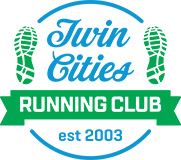| Twin Cities Running ClubA club for beginners and experienced runners alike |
- Home
- Group Runs
- Running Guides
- Summer Running Guide
Summer Running Guide
Summer in Minnesota can be hot and steamy, which can make training uncomfortable. A few hints should make your Summer training more enjoyable: Dress properly! Wear loose-fitting, lightweight, light-colored clothing. Avoid cotton, as it tends to collect and hold moisture. Those fancy fabrics you see in the running stores actually work, so try them. Drink! You will be sweating a lot in the heat, which takes water out of your system. You need to replace it to avoid dehydration. So drink a lot of liquids: for every pound lost during the day's run, drink 16 ounces of water. If you will be going longer than 20 minutes without a water fountain, bring your own. Bring some food too. If you begin to feel light-headed, some food may give you the energy you need. Energy bars and gels are good for this. Eat foods that contain lots of minerals and electrolytes. Minerals and electrolytes (particularly including salt) are lost in sweat, so you will need to replace them. Replacement drinks, bars, and gels are also good for this. Plan courses that allow you to cut your run short. Instead of running one big loop, run several shorter loops. That way, if you're getting too hot and tired, you can quit before it's too late. Begin your run with the wind at your back, and finish with the wind in your face. That way, you can get a cooling breeze later in your run, when you're hot and sweaty. Run when it's cooler. Morning or evening running is best for this, since those are usually the coolest times of the day. The hottest time is not at noon, but in the mid- to late-afternoon. Seek shade if you must run in the middle of the day. Run on shady courses, or on the shady side of the street. If you must run in the sun, try a ventilated hat or visor. Wear a sport sunscreen. Skin cancer can be a serious issue for runners, so do what you can to prevent it. Water on the body does provide a cooling effect. Don't be afraid to run under sprinklers, throw water over your head and shoulders, etc. Avoid hot surfaces. If you can, run on dirt trails rather than hot asphalt. Get acclimatized. You need to adjust to hot weather training. That process usually takes about two weeks, but the adjustment is never complete: No matter how long you have been training in the heat, it will affect your ability to train. Run more slowly in the heat. Your body can handle only so much heat, so don't overburden it. Start slowly, so your body can make the necessary adjustments, then increase your pace only within reason. Get cool before you run. Some time in an air-conditioned room will help to keep your body temperature down after you get outside, enabling you to perform in the heat for a longer period. Use common sense! Running a hard hill workout in 98° heat and high humidity is asking for trouble. Take that day easy or short or off, and run those hills when it's cooler. Running in the rain isn't usually a problem (sometimes it's quite refreshing). There will be a drop in temperature, so wear a t-shirt rather than a singlet, but there's no need to bundle up—it rarely gets that cold. Also, wear a brimmed hat, particularly if you wear glasses. Lightning, on the other hand, is a problem. At the first sign of lightning (thunder, threatening clouds), turn around and head for home. Take shelter if you need to, but avoid standing under big trees—they can be lightning magnets. And don't even think about going out during a thunderstorm or tornado warning. If you feel a heat injury coming on, or recognize the signs of heat injury in a training companion, stop immediately and take precautionary measures. Heat exhaustion is a serious problem, and can progress into heat stroke, which is potentially fatal. Some warning signs are:
In the event of heat exhaustion, go to a cool, shaded place, lie down, pour cool water over yourself or your companion, and drink cool liquids. In the event of heat stroke, you need to lower your body temperature quickly. Go to a cool, shaded place and lie down. Administer a cold water spray or cover yourself with towels dipped in cold water, and have someone fan you. Seek the help of neighbors, and call for medical help. In the event of any heat injury, always err on the side of safety. Never assume that you can continue with your training once you have "cooled off," and do not accept your companion's protestations to that effect. Quit for the rest of the day, and get a physician’s OK before you head back outside. |
